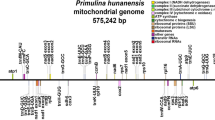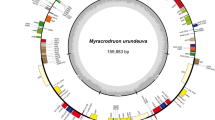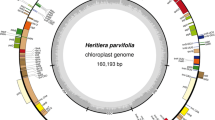Abstract
Melia dubia Cav. is a fast-growing plywood species gaining popularity due to high economic returns. This study aimed to assemble and annotate the chloroplast (cp) genome of M. dubia and compare it with previously published cp genomes within the Meliaceae family. The chloroplast genome was constructed by the de novo and reference-based assembly of paired-end reads generated by long-read sequencing of genomic DNA. The cp genome, sized 171,956 bp, comprised a typical angiosperm quadripartite structure. The large single-copy (LSC) region of 76,055 bp and a small single-copy (SSC) region of 18,693 bp cover 55% of the genome. The pair of inverted repeats (IRA and IRB) were 38,604 bp each (covering 45% of the genome). We identified unique genes (112), including protein-coding genes (79), tRNA (29) and 4 rRNA genes. Phylogenetic analysis using complete cp genomes of 11 species from Meliaceae revealed that M. dubia and M. azedarach shared a sister clade. Comparative analysis using cp genome of M. dubia, M. azedarach and Azadirachta indica revealed a high sequence similarity (> 70%). Five intergenic regions were highly conserved among the three cp genomes. The gene trnG-UCC at LSC region was found to be more divergent in M. dubia and M. azedarach, while it shows complete conservation within M. dubia and A. indica. This is the first report of the chloroplast genome in M. dubia. The available levels of taxonomic expertise and clarity in species delineation within the Melia genus are low. The information generated provides scope for identifying new barcodes which increases the discriminatory power of the species within the genus beyond morphological identification.





Similar content being viewed by others
Data availability
All data generated or analyzed during this study are included in this published article (and its supplementary information files). The complete Chloroplast genome sequence of Melia dubia was submitted to the third party annotation section of the GenBank databases at the National Centre for Biotechnology Information (NCBI) under the accession number TPA: BK059531.
References
Baek J, Park S, Lee J, Min J, Park J, Lee GW (2021) The complete chloroplast genome of Chrysanthemum zawadskii Herbich (Asteraceae) isolated in Korea. Mitochondrial DNA Part B 6(7):1956–1958
Beier S, Thiel T, Münch T, Scholz U, Mascher M (2017) MISA-web: a web server for microsatellite prediction. Bioinformatics 33:2583–2585. https://doi.org/10.1093/bioinformatics/btx198
Benson G (1999) Tandem repeats finder: a program to analyse DNA sequences. Nucleic Acids Res 27(2):573–580
Bolger AM, Lohse M, Usadel B (2014) Trimmomatic: a flexible trimmer for Illumina sequence data. Bioinformatics 30(15):2114–2120
Daniell H, Lin CS, Yu M, Chang WJ (2016) Chloroplast genomes: diversity, evolution, and applications in genetic engineering. Genome Biol 17(1):1–29. https://doi.org/10.1186/s13059-016-1004-2
Frazer KA, Pachter L, Poliakov A, Rubin EM, Dubchak I (2004) VISTA: Computational tools for comparative genomics. Nucleic Acids Res 32:W273-279. https://doi.org/10.1093/nar/gkh458
Freudenthal JA, Pfaff S, Terhoeven N et al (2020) A systematic comparison of chloroplast genome assembly tools. Genome Biol 21:254. https://doi.org/10.1186/s13059-020-02153-6
Geetha S, Venkatramanan KS, Warrier K, Warrier RR (2019) Propagation protocols for enhancing conservation and utilisation of Melia dubia Cav. J Tree Sci 37(2):22–35
Guo X, Wang Z, Cai D, Song L, Bai J (2022) The chloroplast genome sequence and phylogenetic analysis of Apocynum venetum L. PLoS ONE 17(3):e0261710
Howe CJ, Barbrook AC, Koumandou VL, Nisbet RER, Symington HA, Wightman TF (2003) Evolution of the chloroplast genome. Philos Trans R Soc Lond Ser B Biol Sci 358(1429):99–107. https://doi.org/10.1098/rstb.2002.1176
Jiang H, Tian J, Yang J, Dong X, Zhong Z, Mwachala G et al (2022) Comparative and phylogenetic analyses of six Kenya Polystachya (Orchidaceae) species based on the complete chloroplast genome sequences. BMC Plant Biol 22(1):1–21
Jin JJ, Yu WB, Yang JB, Song Y, De Pamphilis CW, Yi TS, Li DZ (2020) GetOrganelle: a fast and versatile toolkit for accurate de novo assembly of organelle genomes. Genome Biol 21(1):1–31. https://doi.org/10.1186/s13059-020-02154-5
Katoh K, Standley DM (2013) MAFFT multiple sequence alignment software version 7: improvements in performance and usability. Mol Biol Evol 30:772–780. https://doi.org/10.1093/molbev/mst010
Kersten B, Rampant PF, Mader M, Le Paslier MC, Bounon R, Berard A, Vettori C, Schroeder H, Leple JC, Fladung M (2016) Genome sequences of Populus tremula chloroplast and mitochondrion: implications for holistic poplar breeding. PLoS ONE 11:e0147209
Koenen EJM, Clarkson JJ, Pennington TD (2015) Chatrou LW (2015) Recently evolved diversity and convergent radiations of rainforest mahoganies (Meliaceae) shed new light on the origins of rainforest hyperdiversity. New Phytol 207:327–339
Kumar S, Stecher G, Tamura K (2016) MEGA7: molecular evolutionary genetics analysis version 7.0 for bigger datasets. Mol Biol Evol 33:1870–1874. https://doi.org/10.1093/molbev/msw054
Kurtz S, Choudhuri JV, Ohlebusch E, Schleiermacher C, Stoye J, Giegerich R (2001) REPuter: the manifold applications of repeat analysis on a genomic scale. Nucleic Acids Res 29(22):4633–4642
Li Q, Wu J, Wang Y, Lian X, Wu F, Zhou L, Zhu S (2017) The phylogenetic analysis of Dalbergia (Fabaceae: Papilionaceae) based on different DNA barcodes. Holzforschung 71(12):939–949. https://doi.org/10.1515/hf-2017-0052
Li F, Xie X, Huang R, Tian E, Li C, Chao Z (2021) Chloroplast genome sequencing based on genome skimming for identification of Eriobotryae Folium. BMC Biotechnol 21(1):1–17
Liu C, Shi LC, Zhu YJ, Chen HM, Zhang JH, Lin XH, Guan XJ (2012) Cpgavas, an integrated web server for the annotation, visualisation, analysis, and genbank submission of completely sequenced chloroplast genome sequences. BMC Genom 13:715. https://doi.org/10.1186/1471-2164-13-715
Liu Y, Zhu X, Wu M, Xu X, Dai Z, Gou G (2022) The complete chloroplast genome of critically endangered Chimonobambusa hirtinoda (Poaceae: Chimonobambusa) and phylogenetic analysis. Sci Rep 12(1):1–12
Lu Z, Dong X, Fan Y, Liu W, Dai J, Han X, Liu J (2022) Complete chloroplast genome of Toona ciliata Roem. Var. pubescens (Franch.) Hand.-Mazz (Meliaceae), ‘Chinese mahogany.’ Mitochondrial DNA Part B 7(3):495–497
Mader M, Pakull B, Blanc-Jolivet C, Paulini-Drewes M, Bouda ZH-N, Degen B, Small I, Kersten B (2018) Complete chloroplast genome sequences of four Meliaceae species and comparative analyses. Int J Mol Sci 19(3):701. https://doi.org/10.3390/ijms19030701
Muellner AN, Samuel R, Johnson SA, Cheek M, Pennington TD, Chase MW (2003) Molecular phylogenetics of Meliaceae (Sapindales) based on nuclear and plastid DNA sequences. Am J Bot 90:471–480
Muellner AN, Pennington TD, Chase MW (2009) Molecular phylogenetics of neotropical Cedreleae (mahogany family, Meliaceae) based on nuclear and plastid DNA sequences reveal multiple origins of “Cedrela odorata.” Mol Phylogenet Evol 52:461–469
Mustardy L, Buttle K, Steinbach G, Garab G (2008) The three-dimensional network of the thylakoid membranes in plants: quasihelical model of the granum-stroma assembly. Plant Cell 20(10):2552–2557. https://doi.org/10.1105/tpc.108.059147
Nguyen HQ, Nguyen TNL, Doan TN, Nguyen TTN, Phạm MH, Le TL et al (2021) Complete chloroplast genome of novel Adrinandra megaphylla Hu species: molecular structure, comparative and phylogenetic analysis. Sci Rep 11(1):1–11
Ohyama K, Fukuzawa H, Kohchi T, Shirai H, Sano T, Sano S, Umesono K, Shiki Y, Takeuchi M, Chang Z, Aota S-I, Inokuchi H, Ozeki H (1986) Chloroplast gene organisation deduced from complete sequence of liverwort marchantia polymorpha chloroplast DNA. Nature 322(6079):572. https://doi.org/10.1038/322572a0.1986
Pennington TD, Styles BT (2003) A generic monograph of the Meliaceae. Blumea 1975 22:419–540
Ruang-Areerate P, Kongkachana W, Naktang C, Sonthirod C, Narong N, Jomchai N et al (2021) Complete chloroplast genome sequences of five Bruguiera species (Rhizophoraceae): comparative analysis and phylogenetic relationships. PeerJ 9:e12268
Saina JK, Gichira AW, Li Z-Z, Hu G-W, Wang Q-F, Liao K (2018) The complete chloroplast genome sequence of Dodonaea viscosa: comparative and phylogenetic analyses. Genetica 146(1):101–113. https://doi.org/10.1007/s10709-017-0003-x
Shinozaki K, Ohme M, Tanaka M, Wakasugi T, Hayashida N, Matsubayashi T, Zaita N, Chunwongse J, Obokata J, Yamaguchi-Shinozaki K, Ohto C, Torazawa K, Meng BY, Sugita M, Deno H, Kamogashira T, Yamada K, Kusuda J, Takaiwa F, Kato A, Tohdoh N, Shimada H, Sugiura M (1986) The complete nucleotide sequence of the tobacco chloroplast genome: its gene organisation and expression. EMBO J 5(9):2043–2049. https://doi.org/10.1002/j.1460-2075.1986.tb04464.x
Sivaraj I, Nithaniyal S, Bhooma V, Senthilkumar U, Parani M (2018) Species delimitation of Melia dubia Cav. from Melia azedarach L. complex based on DNA barcoding. Botany 96(5):329–336. https://doi.org/10.1139/cjb-2017-0148
Song Y, Zhang Y, Xu J, Li W, Li M (2019) Characterisation of the complete chloroplast genome sequence of Dalbergia species and its phylogenetic implications. Sci Rep 9(1):1–10. https://doi.org/10.1038/s41598-019-56727-x
Thiel T, Michalek W, Varshney R, Graner A (2003) Exploiting EST databases for the development and characterisation of gene-derived SSR-markers in barley (Hordeum vulgare L.). Theor Appl Genet 106(3):411–422
Tonti-Filippini J, Nevill PG, Dixon K, Small I (2017) What can we do with 1000 plastid genomes? Plant J 90:808–818
Twyford AD, Ness RW (2017) Strategies for complete plastid genome sequencing. Mol Ecol Resour 17(5):858–868. https://doi.org/10.1111/1755-0998.12626
Williams AV, Miller JT, Small I, Nevill PG, Boykin LM (2016) Integration of complete chloroplast genome sequences with small amplicon datasets improves phylogenetic resolution in Acacia. Mol Phylogenet Evol 96:1–8
Wu L, Cui Y, Wang Q, Xu Z, Wang Y, Lin Y et al (2021) Identification and phylogenetic analysis of five Crataegus species (Rosaceae) based on complete chloroplast genomes. Planta 254(1):1–12
Xie DF, Yu Y, Deng YQ, Li J, Liu HY, Zhou SD, He XJ (2018) Comparative analysis of the chloroplast genomes of the Chinese endemic genus Urophysa and their contribution to chloroplast phylogeny and adaptive evolution. Int J Mol Sci 19(7):1–20. https://doi.org/10.3390/ijms19071847
Zhu S, Liu A, Xie X, Xia M, Chen H (2022) Characterization of the complete chloroplast genome of Wisteriopsis reticulata (Fabaceae): an IRLC legumes. Mitochondrial DNA Part B 7(6):1137–1139
Marçais G, Delcher AL, Phillippy AM, Coston R, Salzberg SL, Zimin A (2018) MUMmer4: a fast and versatile genome alignment system. PLoS Comput Biol 14(1):e1005944. https://mummer4.github.io/
NCBI (2022) Organelle Resources at NCBI. http://www.ncbi.nlm.nih.gov/genome/organelle/. Accessed 29 Mar 2022
Funding
The study was funded by Indian Council of Forestry Research and Education.
Author information
Authors and Affiliations
Contributions
All authors contributed to the study conception and design. AS and KE contributed equally to material preparation, data collection and analysis. SS and KSK provided technical support during the initial phases of analysis. RRW involved in conceptualisation, resources, supervision, funding acquisition, writing original draft and editing. All authors read and approved the final manuscript.
Corresponding author
Ethics declarations
Conflict of interest
On behalf of all authors, the corresponding author states that there is no conflict of interest.
Additional information
The complete Chloroplast genome sequence of Melia dubia was submitted to the third party annotation section of the GenBank databases at the National Centre for Biotechnology Information (NCBI) under the accession number TPA: BK059531.
Supplementary Information
Below is the link to the electronic supplementary material.
Rights and permissions
Springer Nature or its licensor (e.g. a society or other partner) holds exclusive rights to this article under a publishing agreement with the author(s) or other rightsholder(s); author self-archiving of the accepted manuscript version of this article is solely governed by the terms of such publishing agreement and applicable law.
About this article
Cite this article
Samji, A., Eashwarlal, K., Shanmugavel, S. et al. Chloroplast genome skimming of a potential agroforestry species Melia dubia. Cav and its comparative phylogenetic analysis with major Meliaceae members. 3 Biotech 13, 30 (2023). https://doi.org/10.1007/s13205-022-03447-1
Received:
Accepted:
Published:
DOI: https://doi.org/10.1007/s13205-022-03447-1




